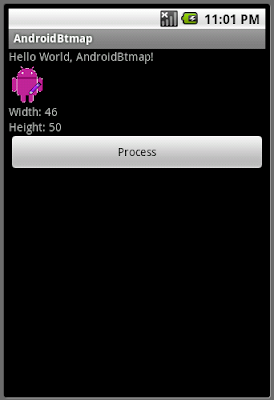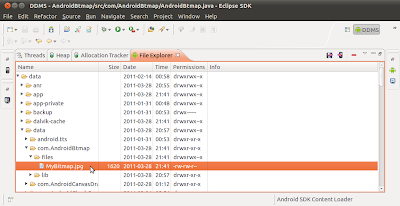通過 Bitmap 類的 getPixels() 方法可以把 Bitmap 複製到一個整數矩陣. 每個元素對應 Bitmap 的一點. 而 32 bit 分別代表 alpha, 紅, 綠, 藍. 這樣我們便可以處理每個點. 本例子中, 每次用戶點擊按鈕, 便把圖像的紅, 綠, 藍迴轉一次(r->b, b->g, g->r), 然後利用 createBitmap() 和 setPixels() 方法創建新的 Bitmap.

<?xml version="1.0" encoding="utf-8"?>
<LinearLayout xmlns:android="http://schemas.android.com/apk/res/android"
android:orientation="vertical"
android:layout_width="fill_parent"
android:layout_height="fill_parent"
>
<TextView
android:layout_width="fill_parent"
android:layout_height="wrap_content"
android:text="@string/hello"
/>
<ImageView
android:id="@+id/myimage"
android:layout_width="wrap_content"
android:layout_height="wrap_content"
/>
<TextView
android:id="@+id/myimagewidth"
android:layout_width="fill_parent"
android:layout_height="wrap_content"
/>
<TextView
android:id="@+id/myimageheight"
android:layout_width="fill_parent"
android:layout_height="wrap_content"
/>
<Button
android:id="@+id/process"
android:layout_width="fill_parent"
android:layout_height="wrap_content"
android:text="Process"
/>
</LinearLayout>
package com.AndroidBtmap;
import android.app.Activity;
import android.graphics.Bitmap;
import android.graphics.BitmapFactory;
import android.os.Bundle;
import android.view.View;
import android.widget.Button;
import android.widget.ImageView;
import android.widget.TextView;
public class AndroidBtmap extends Activity {
Bitmap bitmap;
ImageView myImage;
/** Called when the activity is first created. */
@Override
public void onCreate(Bundle savedInstanceState) {
super.onCreate(savedInstanceState);
setContentView(R.layout.main);
myImage = (ImageView)findViewById(R.id.myimage);
TextView myImageWidth = (TextView)findViewById(R.id.myimagewidth);
TextView myImageHeight = (TextView)findViewById(R.id.myimageheight);
Button buttonProcess = (Button)findViewById(R.id.process);
bitmap = BitmapFactory.decodeResource(getResources(), R.drawable.androidbiancheng);
int bitmapWidth = bitmap.getWidth();
int bitmapHeight = bitmap.getHeight();
myImage.setImageBitmap(bitmap);
myImageWidth.setText("Width: " + String.valueOf(bitmapWidth));
myImageHeight.setText("Height: " + String.valueOf(bitmapHeight));
buttonProcess.setOnClickListener(new Button.OnClickListener(){
@Override
public void onClick(View arg0) {
// TODO Auto-generated method stub
bitmap = doProcess(bitmap);
myImage.setImageBitmap(bitmap);
myImage.invalidate();
}});
}
private Bitmap doProcess(Bitmap src){
int bmWidth = src.getWidth();
int bmHeight = src.getHeight();
int[] newBitmap = new int[bmWidth * bmHeight];
src.getPixels(newBitmap, 0, bmWidth, 0, 0, bmWidth, bmHeight);
for (int h = 0; h < bmHeight; h++){
for (int w = 0; w < bmWidth; w++){
int index = h * bmWidth + w;
int alpha = newBitmap[index] & 0xff000000;
int r = (newBitmap[index] >> 16) & 0xff;
int g = (newBitmap[index] >> 8) & 0xff;
int b = newBitmap[index] & 0xff;
int t = r; //Swap the color
r = g;
g = b;
b = t;
newBitmap[index] = alpha | (r << 16) | (g << 8) | b;
}
}
Bitmap bm = Bitmap.createBitmap(bmWidth, bmHeight, Bitmap.Config.ARGB_8888);
bm.setPixels(newBitmap, 0, bmWidth, 0, 0, bmWidth, bmHeight);
return bm;
}
}






